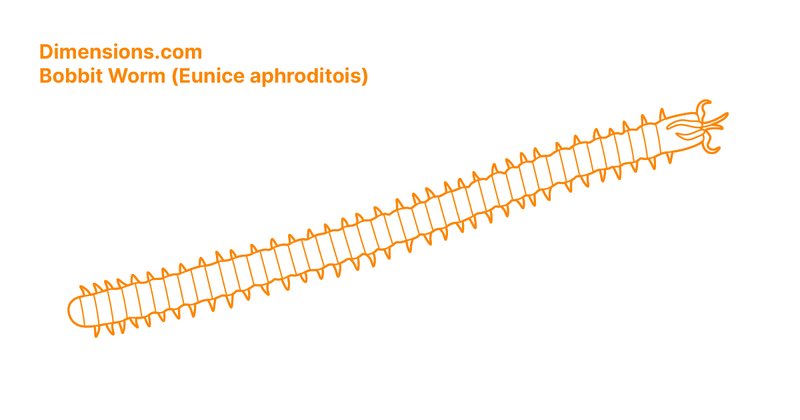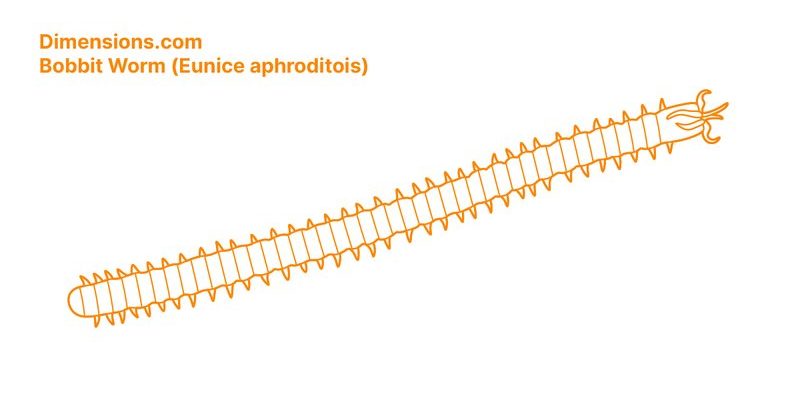
Bobbit worms, named after the infamous Lorena Bobbitt, are long, segmented worms that can grow up to ten feet in length. They usually live in burrows in the sand or mud, leaving only their fierce jaws visible. Their anatomy is tailored for ambushing unsuspecting prey, like fish and crustaceans that swim close to their hiding spots. In this article, we’ll dive deep into the anatomy of the Bobbit worm and discover how it uses its unique features to catch food. So, grab a cup of coffee, and let’s explore together!
What is a Bobbit Worm?
The Bobbit worm belongs to a group of marine polychaete worms. You might be wondering what that means. Polychaetes are segmented worms that often have bristles on their bodies. They live in various marine environments, from tidal pools to the deep sea. Bobbit worms specifically are known for their predatory nature and striking appearances. These worms can have a range of colors, including deep reds, greens, and oranges, which help them blend into their surroundings.
Adult Bobbit worms can grow anywhere from three to ten feet long, with some even reaching lengths of 12 feet in rare cases. They generally have a segmented body with a smooth, almost shiny texture. The first segment is often the most colorful and has specialized structures that help them sense their environment. Picture this: a long, slender creature, usually hidden from view, with just its head and jaws poking out from the sand. This design allows them to remain concealed, waiting patiently for food to come by.
Interestingly, Bobbit worms can also regenerate their body parts. If they lose a segment, it can grow back over time. This ability is useful in the wild, where they might encounter predators. Their unique adaptations make them not just survivors, but highly effective hunters.
The Bobbit Worm’s Ambush Strategy
At the heart of the Bobbit worm’s hunting success is its ambush strategy. Here’s the thing: they don’t chase after prey like some predators do. Instead, they lie in wait for unsuspecting fish or crustaceans to swim too close. When the time is right, they strike with astonishing speed. This ambush tactic is a key part of their anatomy, and it’s fascinating to break it down.
The worm hides in a burrow, often covered with sand and debris, making it almost invisible. Its head, which features two powerful jaws, is equipped with sharp teeth that can deliver a lethal bite. When prey comes too close, the worm extends its head rapidly—a movement that can happen in just a fraction of a second. Before the prey knows what hit it, the worm has seized its meal, dragging it back into its burrow.
While watching video clips of these worms in action can be thrilling, there’s no substitute for seeing how their anatomy supports this ambush technique. The combination of patience, speed, and precision in their hunting style is a perfect example of evolution at work.
Bobbit Worm Anatomy: Key Features
Now let’s break down the anatomy of the Bobbit worm and see how its features contribute to its ambush design. Each part of its body plays a vital role in its survival.
1. Segmented Body
The Bobbit worm’s body is made up of segments that provide flexibility and strength. Each segment can respond independently, allowing the worm to maneuver cunningly within its burrow. This segmentation is crucial because it helps the animal navigate the underwater terrain while remaining hidden from potential threats.
2. Powerful Jaws
The most striking feature of the Bobbit worm is its powerful jaws. These aren’t just any jaws; they’re incredibly strong and equipped with sharp teeth. When a Bobbit worm launches its attack, it uses these jaws to grasp and hold onto its prey firmly. This ability means that once something gets too close, it’s often too late for the unfortunate animal to escape.
3. Sensory Structures
On its head, the Bobbit worm has specialized sensory structures that help it detect vibrations in the water. These sensitive appendages can sense even the faintest movements, alerting the worm to the presence of potential prey. Think of these structures as the worm’s “ears” and “eyes,” allowing it to perceive its surroundings with remarkable accuracy.
Habitat and Distribution
Bobbit worms thrive in various marine environments, primarily in tropical and subtropical oceans. They prefer sandy or muddy substrates, often found in shallow waters, but some species can be found deeper. Their choice of habitat is closely linked to their ambush hunting style.
In shallow regions, the conditions are often optimal for catching prey. The availability of fish, crabs, and other small organisms means they have plenty of food options. Here’s an interesting fact: since Bobbit worms are often hidden in their burrows, they can sometimes be challenging to spot during dives or while snorkeling. This camouflage is yet another layer of their ambush strategy.
These worms are usually solitary creatures, which means they don’t form colonies like some other marine life. Instead, they carve out their own territories in the sand or muck. This solitary existence helps reduce competition for food and allows them to maintain their ambush spots without interference.
Importance of Bobbit Worms in Their Ecosystem
Bobbit worms, while fearsome hunters, play a vital role in the marine ecosystem. They help maintain the balance of marine populations by preying on various smaller creatures. This predation prevents overpopulation, which could disrupt the ecosystem. By keeping fish and crustacean numbers in check, Bobbit worms contribute to a healthier seafloor community.
Their presence is also a sign of a healthy marine environment. In areas where Bobbit worms thrive, it often indicates good water quality and biodiversity. Healthy ecosystems depend on species like the Bobbit worm to fulfill specific roles, and losing them could lead to cascading effects throughout the food web.
In addition, their remarkable ability to regenerate body parts has intrigued scientists, leading to studies on the potential applications in medicine and biological research. Who knows? Understanding Bobbit worms better might even lead to breakthroughs in regenerative medicine for humans!
Bobbit worms are more than just peculiar names and impressive lengths. Their incredible anatomy is a testament to nature’s creativity and adaptability. From their ambush strategy to their specialized features, Bobbit worms showcase the beauty and complexity of marine life.
Whether you’re a seasoned marine biologist or a curious enthusiast, the world of Bobbit worms is captivating. Their role in the ecosystem, unique adaptations, and striking hunting techniques remind us that there’s so much to learn from the species that lurk beneath the surface. So, next time you think about ocean life, remember the stealthy Bobbit worm, hidden away in its sandy lair, waiting for the perfect moment to strike.

